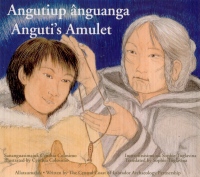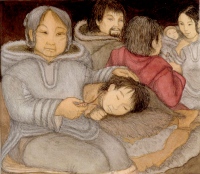| ________________
CM . . . . Volume XVII Number 24. . . .February 25th, 2010. 
 |
Angutiup ânguanga = Anguti's Amulet.
Central Coast of Labrador Archaeology Partnership. illustrated by Cynthia Colosimo. Translated by Sophie Tuglavina.
St. John's, NL: Pennywell Books/Flanker Press, 2010.
38 pp., pbk., $14.95.
ISBN 978-1-897317-91-4.
Subject Headings:
Inuit-Newfoundland and Labrador-Labrador-Juvenile literature.
Excavations (Archeology)-Newfoundland and Labrador-Labrador-Juvenile literature.
Grades 2-6 / Ages 7-11.
Review by Shelbey Krahn.
***1/2 / 4
|
| |
|

excerpt:
The evening before the last of the big storms finally cleared, my anànsiak had one of her nights when she consulted with the spirits and was not there with us in the house. When we woke, she
warned us that the clearing weather brought danger with it. She talked of changing winds that could endanger the hunters on the ice. During the night she had carefully sewn several small amulets onto the inside of my parka, so that some of her power might protect me in the days to
come."
In both the English and Inuktitut languages, Anguti's Amulet shares a realistic Inuit adventure story set in early 1700's Labrador, as well as interesting archaeological details from excavating the site in the 21st Century.
Anguti's grandmother is a female shaman who predicts changing winds which will endanger hunters. Despite the danger, the half-starved hunters go hunting, leaving children like Anguti and his younger sister, Tukkekina, behind. Watching the hunters from a high vantage point on a hill, the two children see a dark spot on the ice, a spot which they think must be a large seal. Not able to communicate their discovery to the hunters, they attempt to kill the seal themselves. They succeed, but a change in the wind pushes the ice free from the shore, and the children are cut off from their family Utilizing the seal for food and shelter, the children drift on their ice flow for three days and three nights. They manage to transfer themselves onto some shore-fast ice near Uivaluk and are taken home by a stranger to Aiviktok. In time, the children are taken home. As Anguti falls off to sleep, his grandmother bends and touches his amulet: "I always knew you were safe."
 The detailed illustrations are a combination of pencil, pencil crayon and watercolour. There is a discrepancy between the text and the illustrations. In the text, the grandmother sews several small amulets into Anguti's parka, but in the illustrations and in the title of the book, Anguti is given a single amulet in the form of a pendant on a leather cord. The illustrations are mostly well-done, communicating much about the Inuit way of life in that time and place, but they also cause some confusion. On the book's cover, Anguti looks to be 12-years-old, but he looks 10-years-old standing beside his father and eight-years-old standing beside his grandmother. The illustration where Anguti and his grandmother are on the hill overlooking the houses also causes confusion because the people below are so large - the kneeling man is much larger than the standing man and the woman, even though the woman is closest and should be largest. Also, from the reference
photograph, the houses are so tall we should not see the men standing behind them at all unless they are very far away, and they should then be very, very small. The detailed illustrations are a combination of pencil, pencil crayon and watercolour. There is a discrepancy between the text and the illustrations. In the text, the grandmother sews several small amulets into Anguti's parka, but in the illustrations and in the title of the book, Anguti is given a single amulet in the form of a pendant on a leather cord. The illustrations are mostly well-done, communicating much about the Inuit way of life in that time and place, but they also cause some confusion. On the book's cover, Anguti looks to be 12-years-old, but he looks 10-years-old standing beside his father and eight-years-old standing beside his grandmother. The illustration where Anguti and his grandmother are on the hill overlooking the houses also causes confusion because the people below are so large - the kneeling man is much larger than the standing man and the woman, even though the woman is closest and should be largest. Also, from the reference
photograph, the houses are so tall we should not see the men standing behind them at all unless they are very far away, and they should then be very, very small.
Of the 38 pages, 18 pages are devoted to the archaeological dig at Long Tickle, the setting for Anguti's story. The preceding story makes the archaeological details much more relevant and interesting. The search-and-find element, searching for archaeological artefacts in the story's illustrations, solidifies the connections between the research and the lives of those who lived long ago. The vivid photographs and other well explained details make archaeology come alive.
In both parts of the book, the two languages, Inuktitut and English, are separated as clearly as possible. In the story and for much of the archaeological description, Inuktitut is high and/or left on the page and English is low and/or right. When that is less feasible, English is green and Inuktitut is black.
Highly recommended for those interested in the Inuktitut language, Inuit culture, Canadian history, and archaeology. Recommended for all Canadian libraries and Grades 2‑6 classrooms.
Highly Recommended.
Shelbey Krahn is a librarian for the School of Education at Laurentian University in Sudbury, ON.

To comment on this title or this review, send mail to
cm@umanitoba.ca.
Copyright © the Manitoba Library Association. Reproduction for personal use is permitted only if this copyright notice is maintained. Any other reproduction is prohibited without permission.
NEXT REVIEW |
TABLE OF CONTENTS FOR THIS ISSUE- February 25, 2011.
AUTHORS |
TITLES |
MEDIA REVIEWS |
PROFILES |
BACK ISSUES |
SEARCH |
CMARCHIVE |
HOME |

 The detailed illustrations are a combination of pencil, pencil crayon and watercolour. There is a discrepancy between the text and the illustrations. In the text, the grandmother sews several small amulets into Anguti's parka, but in the illustrations and in the title of the book, Anguti is given a single amulet in the form of a pendant on a leather cord. The illustrations are mostly well-done, communicating much about the Inuit way of life in that time and place, but they also cause some confusion. On the book's cover, Anguti looks to be 12-years-old, but he looks 10-years-old standing beside his father and eight-years-old standing beside his grandmother. The illustration where Anguti and his grandmother are on the hill overlooking the houses also causes confusion because the people below are so large - the kneeling man is much larger than the standing man and the woman, even though the woman is closest and should be largest. Also, from the reference
photograph, the houses are so tall we should not see the men standing behind them at all unless they are very far away, and they should then be very, very small.
The detailed illustrations are a combination of pencil, pencil crayon and watercolour. There is a discrepancy between the text and the illustrations. In the text, the grandmother sews several small amulets into Anguti's parka, but in the illustrations and in the title of the book, Anguti is given a single amulet in the form of a pendant on a leather cord. The illustrations are mostly well-done, communicating much about the Inuit way of life in that time and place, but they also cause some confusion. On the book's cover, Anguti looks to be 12-years-old, but he looks 10-years-old standing beside his father and eight-years-old standing beside his grandmother. The illustration where Anguti and his grandmother are on the hill overlooking the houses also causes confusion because the people below are so large - the kneeling man is much larger than the standing man and the woman, even though the woman is closest and should be largest. Also, from the reference
photograph, the houses are so tall we should not see the men standing behind them at all unless they are very far away, and they should then be very, very small.